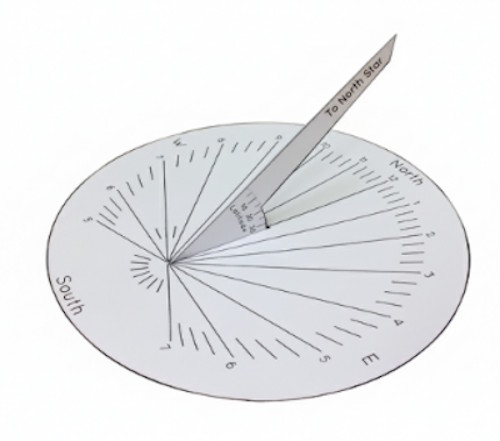For thousands of years, people have used sundials to measure the passage of time by watching the Sun’s apparent movement across the sky. In fact, the earliest device for telling time was likely the gnomon – a simple upright stick dating back to around 3500 BCE. By looking at the length and direction of its shadow, people could figure out the time of day. Sundials remained the primary tool for telling time right up until the early 19th century, and when carefully placed, they can be accurate down to the minute!
In this activity you will assemble your own simple sundial and see how shadows reveal the hidden clock of the sky.
Introduction
At the heart of any sundial is the gnomon, a thin rod or stick that casts a shadow, and the dial, a surface where the hours are marked. As Earth spins on its axis, the Sun appears to move across the sky, and the shadow cast by the gnomon shifts with it. This simple principle connects our daily experience of time to the motion of our planet.
There are many different types of sundials:
-
Horizontal Sundial: This sundial has a flat, horizontal dial with hour lines and a gnomon standing upright at the center. It is the most common type and has been widely used for centuries to track time in open spaces. The horizontal design can also be adapted to different latitudes, except the design becomes very awkward for regions close to the equator where the gnomon needs to lie almost horizontally, and the marks become very squashed and unevenly spaced.
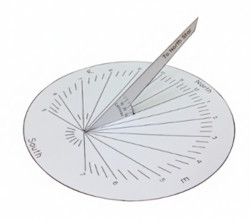 Image Credit: Krieger, John. Lyncean Education
Image Credit: Krieger, John. Lyncean Education -
Vertical Sundial: This sundial is mounted on a vertical wall, with the gnomon sticking out to cast a shadow on the dial. The gnomon is aligned with the celestial pole (toward the North Star in the Northern Hemisphere), and the wall usually faces true south, so the shadow moves correctly throughout the day. On walls that are tilted east or west, the markings must be calculated differently based on the wall’s angle for the sundial to work accurately. Vertical sundials are often seen on buildings, where they serve as both decoration and a practical way to tell time.
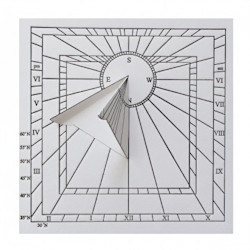 Image Credit: The Passenger Press
Image Credit: The Passenger Press -
Equatorial Sundial: It has a dial with marks that are evenly spaced, like the numbers on a clock. The dial is tilted so that its plane is parallel to Earth’s equator, and the gnomon is aligned with Earth’s axis. This design makes it easy to read the time. The equatorial design can be adapted to any location on Earth and is well suited for higher latitudes.
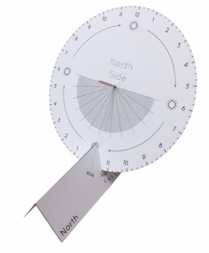 Image Credit: Krieger, John. Lyncean Education
Image Credit: Krieger, John. Lyncean Education -
Polar Sundial: The dial plate of this sundial is set parallel to the Earth’s polar axis, with its gnomon aligned along the same axis, pointing toward the celestial pole. The hour lines are parallel, making it easy to read the time accurately. This design is better suited for tracking the overhead path of the sun at the equatorial regions.
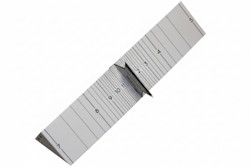 Image Credit: Krieger, John. Lyncean Education
Image Credit: Krieger, John. Lyncean Education
Activity
Requirements
Templates for horizontal, equatorial and polar sundials for the latitude for which the sundial is being constructed, scissors, glue and a toothpick.
Procedure
-
Decide which type of sundial you want to build.
-
Print the template for your chosen sundial and follow the instructions provided to assemble it.
-
Set up your sundial in a sunny spot, making sure to orient it correctly according to the design in your template.
-
Look for patterns in how the shadow moves. Is it moving clockwise, counterclockwise, or in a straight line? Based on your observations, predict where the shadow will fall at a later time of the day. Write down your prediction. Check the shadow at the predicted time and see if your prediction was correct. Record the results.
-
Use your sundial to read the time. Compare it with the time shown by a modern clock and note any differences between the two.
Reflect and Discuss
-
Does your sundial show the local solar time where you are, or the official time of your country according to the time zone? How do they differ?
-
Why does an equatorial sundial have dials printed on both sides?
-
Was there any difference between the time shown by the sundial and the modern clock. What factors could cause this difference?
-
One limitation of a sundial is that it cannot tell time at night. Can you think of other ways to measure time when it’s dark? Try designing or building a simple device and check how accurate it can be.
Downloads
- Templates for horizontal (suitable for 20° N), equatorial and polar sundials.
- Templates for horizontal sundial for various latitudes.
- Template for equatorial sundial for northern and southern hemispheres.
- Template for polar sundial for northern and southern hemispheres.
References and Further Reading
-
Krieger, John. "Simple Paper Sundials". Science Projects: Astronomy, Lyncean Education. Accessed October 12, 2025.

